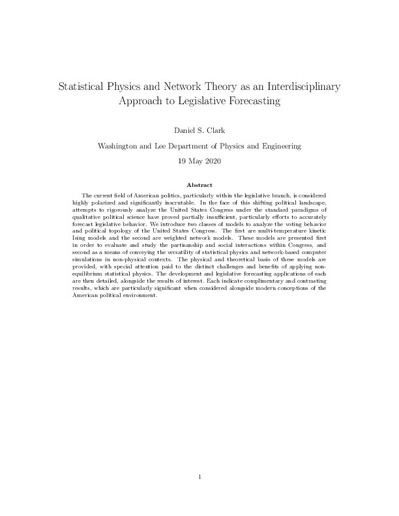| dc.rights.license | In Copyright | en_US |
| dc.creator | Clark, Daniel Scarbrough | |
| dc.date.accessioned | 2020-05-22T13:22:05Z | |
| dc.date.available | 2020-05-22T13:22:05Z | |
| dc.date.created | 2020 | |
| dc.identifier | WLURG38_Clark_PHYS_2020 | |
| dc.identifier.uri | http://hdl.handle.net/11021/34749 | |
| dc.description | Thesis; [FULL-TEXT FREELY AVAILABLE ONLINE] | en_US |
| dc.description | Daniel Scarbrough Clark is a member of the Class of 2020 of Washington and Lee University. | en_US |
| dc.description.abstract | The current field of American politics, particularly within the legislative branch, is considered highly polarized and signicantly inscrutable. In the face of this shifting political landscape, attempts to rigorously analyze the United States Congress under the standard paradigms of qualitative political science have proved partially insufficient, particularly efforts to accurately forecast legislative behavior. We introduce two classes of models to analyze the voting behavior and political topology of the United States Congress. The first are multi-temperature kinetic Ising models and the second are weighted network models. These models are presented first in order to evaluate and study the partisanship and social interactions within Congress, and second as a means of conveying the versatility of statistical physics and network-based computer simulations in non-physical contexts. The physical and theoretical basis of these models are provided, with special attention paid to the distinct challenges and benefits of applying non-equilibrium statistical physics. The development and legislative forecasting applications of each are then detailed, alongside the results of interest. Each indicate complimentary and contrasting results, which are particularly significant when considered alongside modern conceptions of the American political environment. | en_US |
| dc.description.statementofresponsibility | Daniel S. Clark | |
| dc.format.extent | 49 pages | en_US |
| dc.language.iso | en_US | en_US |
| dc.rights | This material is made available for use in research, teaching, and private study, pursuant to U.S. Copyright law. The user assumes full responsibility for any use of the materials, including but not limited to, infringement of copyright and publication rights of reproduced materials. Any materials used should be fully credited with the source. | en_US |
| dc.rights.uri | http://rightsstatements.org/vocab/InC/1.0/ | en_US |
| dc.subject.other | Washington and Lee University -- Honors in Physics | en_US |
| dc.title | Statistical Physics and Network Theory as an Interdisciplinary Approach to Legislative Forecasting | en_US |
| dc.type | Text | en_US |
| dcterms.isPartOf | RG38 - Student Papers | |
| dc.rights.holder | Clark, Daniel Scarbrough | |
| dc.subject.fast | Politics and government -- Forecasting | en_US |
| dc.subject.fast | Statistical physics | en_US |
| dc.subject.fast | System analysis -- Computer simulation | en_US |
| local.department | Physics | en_US |
| local.scholarshiptype | Honors Thesis | en_US |
